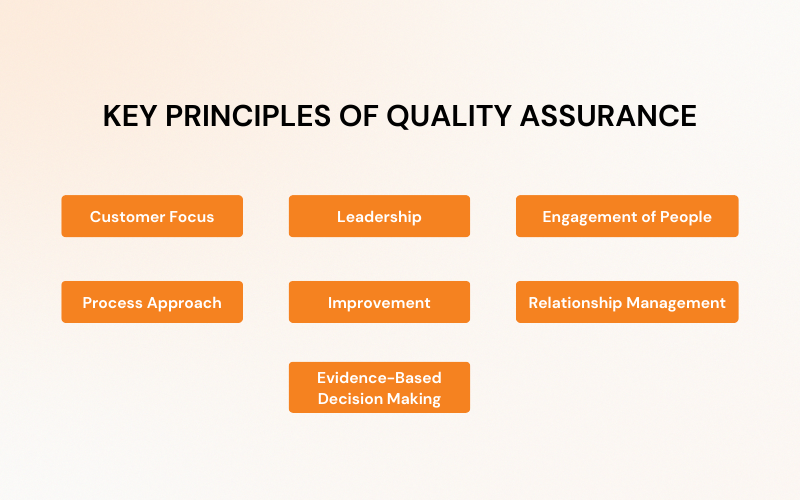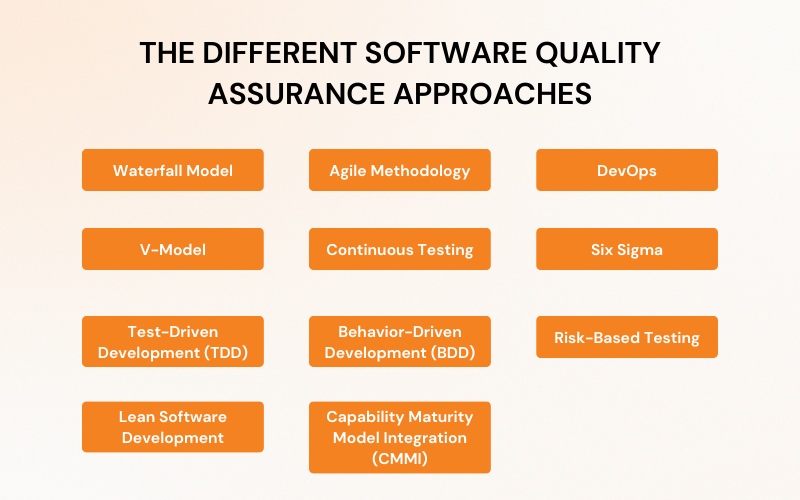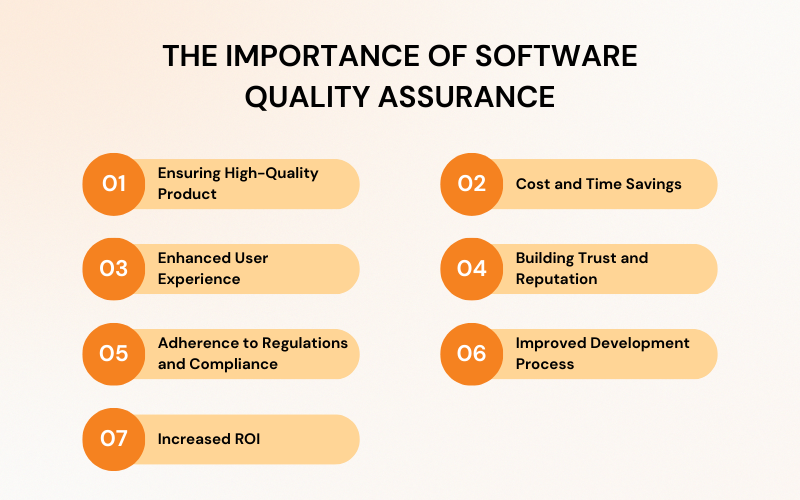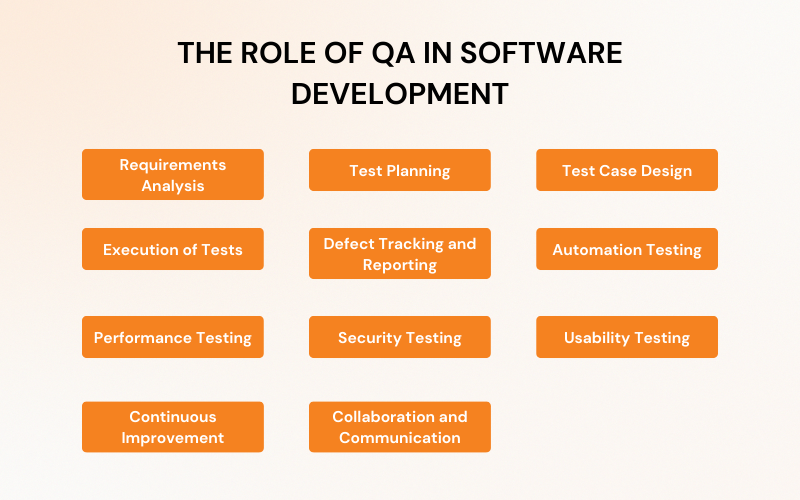The Role and Importance of Software Quality Assurance

Quality assurance (QA) is a crucial aspect of any industry, ensuring that products and services meet or exceed customer expectations. Whether it’s manufacturing, software development, healthcare, or any other sector, the pursuit of quality is paramount. In this article, we will delve into the intricacies of software quality assurance, exploring its definition, principles, methodologies, and the impact it has on businesses and consumers alike.
What is Quality Assurance (QA)?
Quality assurance is a systematic process implemented by organizations to ensure that products or services consistently meet specified quality standards. The goal is to prevent defects, errors, and inconsistencies, ensuring that the final output is of the highest quality possible. QA involves a combination of processes, tools, and methodologies designed to monitor, assess, and improve various aspects of production or service delivery.
The International Organization for Standardization (ISO) plays a pivotal role in shaping QA practices and delineating the processes integral to QA implementation. Frequently, QA is associated with the ISO 9000 international standard, and numerous companies leverage ISO 9000 to verify the effectiveness and presence of their quality assurance systems.
The formalization of QA as a structured practice originated in the manufacturing sector and has progressively permeated diverse industries, including the realm of software development. This demonstrates the universality and adaptability of QA concepts across a broad spectrum of professional domains.
Key Principles of Quality Assurance

The Seven Principles of Quality Management, often associated with the ISO 9000 family of standards, are fundamental concepts that guide organizations in achieving and maintaining high-quality standards. These principles provide a framework for effective quality management. Here are the seven principles:
- Customer Focus: Organizations should understand and meet customer requirements and strive to exceed customer expectations. Customer satisfaction is a key measure of quality success.
- Leadership: Effective leadership is crucial for creating and maintaining a unified direction and purpose within the organization. Leaders establish a clear vision, set objectives, and foster a culture of quality.
- Engagement of People: Employees at all levels play a vital role in achieving quality objectives. Engaging and empowering people, providing training, and promoting a culture of involvement contribute to improved performance.
- Process Approach: Organizations should view their activities as interconnected processes. Managing these processes systematically helps in achieving efficiency, consistency, and the ability to meet objectives.
- Improvement: Continuous improvement is a key principle. Organizations should regularly evaluate their processes, products, and systems to identify areas for improvement. This involves a commitment to ongoing learning and innovation.
- Evidence-Based Decision Making: Decisions should be based on analysis and evaluation of data and information. Using evidence to inform decision-making ensures that choices are grounded in facts and contribute to achieving organizational goals.
- Relationship Management: Organizations benefit from building mutually beneficial relationships with their suppliers and partners. Collaborative relationships enhance the ability to create value and deliver quality products and services.
What Is Quality Assurance In Software Development?
Software Quality Assurance (SQA) is a systematic approach to identifying patterns and implementing actions that enhance software development cycles. Rectifying coding errors, while essential, can inadvertently lead to unintended consequences, potentially breaking other features and functionalities.
The significance of SQA for developers lies in its ability to preemptively detect errors, thereby saving time and reducing development expenses. Despite the existence of SQA processes, software updates can still introduce defects, commonly referred to as bugs.
Various SQA strategies have been employed, with the Capability Maturity Model Integration (CMMI) being one notable example. CMMI focuses on performance improvement by assessing maturity levels within an organization and suggesting optimizations for enhancement. Maturity levels range from disorganization to full optimization.
Over time, software development methodologies incorporating SQA have emerged, including Waterfall, Agile, and Scrum.
Waterfall follows a traditional linear approach, progressing through stages such as gathering requirements, formalizing design, code implementation, testing, and release. Its perceived slowness prompted the development of alternative methods.
Agile, a team-oriented methodology, treats each step in the work process as a sprint, fostering adaptability but sacrificing predictability as the project scope can easily change.
Scrum combines elements of both methodologies, organizing developers into teams for specific tasks, each divided into multiple sprints.
When implementing a QA system, it is crucial to establish goals for the standard. Evaluating the advantages and tradeoffs of different approaches, such as maximizing efficacy, reducing costs, or minimizing errors, is essential. Management commitment to process changes and collaborative efforts to support the QA system and define quality standards are paramount.
What Are the Different Software Quality Assurance Approaches?

There are various software quality assurance (SQA) approaches, methodologies, and frameworks designed to ensure that software development processes and products meet specified quality standards. Here are some of the commonly used SQA approaches:
1. Waterfall Model
The Waterfall model is a sequential and linear approach to software development. SQA activities are typically performed in each phase before progressing to the next one. It is well-structured but can be less adaptable to changes.
2. Agile Methodology
Agile is an iterative and flexible approach that emphasizes collaboration, adaptability, and customer feedback. In Agile, SQA is integrated throughout the development process, with continuous testing and quality checks in each iteration.
3. DevOps
DevOps is a culture and set of practices that aim to improve collaboration between development and operations teams. SQA in DevOps is about integrating testing and quality checks into the continuous integration and continuous deployment (CI/CD) pipeline for faster and more reliable releases.
4. Lean Software Development
Lean principles focus on eliminating waste, improving efficiency, and delivering value to customers. SQA in Lean aims to identify and eliminate processes or activities that do not contribute to software quality.
5. Capability Maturity Model Integration (CMMI)
CMMI is a process improvement framework that provides a set of best practices for software development and SQA. It defines maturity levels, and organizations can assess their processes against these levels to identify areas for improvement.
6. Six Sigma
Six Sigma is a data-driven approach to process improvement that aims to reduce defects and variations in processes. In SQA, Six Sigma can be used to measure and improve the quality of software development processes.
7. Test-Driven Development (TDD)
TDD is an approach where tests are written before the code is developed. SQA in TDD ensures that tests are an integral part of the development process, and it encourages incremental development with a focus on meeting specific requirements.
8. Behavior-Driven Development (BDD)
BDD focuses on collaboration between developers, QA, and non-technical stakeholders. SQA in BDD involves creating and executing tests based on the desired behavior of the software, often expressed in natural language.
9. Risk-Based Testing
Risk-based testing involves prioritizing testing efforts based on identified risks. SQA in this approach focuses on assessing and mitigating risks that could impact the quality of the software.
10. V-Model
The V-Model is an extension of the Waterfall model where testing is performed in parallel with each development stage. SQA activities in the V-Model are aligned with specific development phases, ensuring that testing is integrated from the early stages.
11. Continuous Testing
Continuous Testing is an approach that emphasizes testing throughout the software development life cycle, with automated testing integrated into the CI/CD pipeline. This ensures that testing is conducted continuously, providing fast and frequent feedback.
Choosing the most suitable SQA approach depends on factors such as project requirements, team dynamics, and the nature of the software being developed. Many organizations adopt a combination of these approaches to tailor their SQA practices to specific needs.
Read more: 9 Tips To Improve The Efficiency Of Software Testing
Key Differences Between QA and QC
Quality Assurance (QA) and Quality Control (QC) are related concepts in the context of ensuring the quality of products or processes, including in software development. While they share similarities, they serve different purposes in the overall quality management process. Here’s a breakdown of the distinctions:
Purpose and Focus
- QA (Quality Assurance): QA is a proactive and process-oriented approach. It focuses on preventing defects and ensuring that the entire software development process is aligned with quality standards. QA aims to improve and optimize processes to avoid issues before they occur.
- QC (Quality Control): QC is a reactive and product-oriented approach. It involves activities that are focused on identifying and correcting defects in the final product. QC is concerned with inspecting, testing, and validating the product to ensure it meets the specified requirements.
When It Occurs
- QA: Occurs throughout the entire software development lifecycle, from planning to deployment. It is a continuous process that involves setting standards, conducting audits, and implementing improvements.
- QC: Takes place after the product is developed. It involves activities such as testing, inspections, and reviews to identify and rectify defects before the product is released.
Key Differences Between QA vs Testing
QA (Quality Assurance) and testing are distinct but complementary aspects of the software development process.
Quality Assurance (QA)
QA is centred around establishing and maintaining processes and procedures that contribute to the overall quality of a product. It involves activities that ensure adherence to standards and best practices throughout the entire software development lifecycle. QA aims to prevent defects and improve the development process. It encompasses various activities such as process audits, management of development methodologies, and establishment of quality standards.
Testing
Testing, on the other hand, is a more tactical and hands-on process. It involves systematically evaluating a product to identify defects or issues. Testing verifies that the product functions as expected and meets the specified requirements. It can include activities like unit testing, integration testing, system testing, and user acceptance testing. The primary goal of testing is to ensure that the software behaves correctly and fulfils its intended purpose.
Here’s a table summarizing the key differences between Software Quality Assurance (SQA), Quality Control (QC), and Testing:
| Aspect | Software Quality Assurance (SQA) | Quality Control (QC) | Testing |
| Focus | Prevention of defects through process improvement | Identification and correction of defects | Execution of test cases to validate software functionality |
| Objective | Ensuring that the development process is well-defined and adhered to | Ensuring that the product meets specified quality standards | Verifying that the software functions correctly and meets requirements |
| When Applied | Throughout the entire software development life cycle | After the development phase, before release | During the testing phase of the SDLC |
| Activities | Process improvement, standards compliance, training | Inspection, review, and corrective actions | Test planning, design, execution, and defect reporting |
| Involvement | Involves all stages of development, including planning and requirements | Focuses on the verification of the final product | Primarily associated with the testing phase, though planning starts earlier |
| Preventive or Corrective | Preventive – aims to prevent defects by improving processes | Corrective – aims to identify and correct defects | Both preventive and corrective, as defects are identified and fixed |
| Ownership | Shared responsibility among the entire development team | Typically the responsibility of the quality control team | Primarily the responsibility of the testing team |
| Metrics | Process metrics, compliance metrics, efficiency metrics | Defect metrics, inspection metrics | Test coverage metrics, defect density, pass/fail rates |
| Automation | May involve process automation, but not focused on test automation | May involve the use of automated testing tools | Primarily focused on automated test execution and regression testing |
| Outcome | Improved development processes, reduced defects, higher quality products | Identified and corrected defects, compliance with quality standards | Identification of defects, validation of software functionality |
| Examples | Establishing coding standards, conducting training programs | Code reviews, inspections, and testing activities | Unit testing, integration testing, system testing, acceptance testing |
What Is the Importance of Software Quality Assurance?

Quality Assurance (QA) plays a crucial role in software development, acting as the guardian of quality at every stage of the development process. Its importance stems from several key benefits:
- Ensuring High-Quality Product: QA meticulously tests the software for bugs, usability issues, performance bottlenecks, and security vulnerabilities. This proactive approach helps developers deliver a reliable, efficient, and user-friendly product that meets user expectations and industry standards.
- Cost and Time Savings: By identifying and fixing issues early in the development cycle, QA prevents expensive post-release fixes and saves valuable development time. This proactive approach minimizes resource wastage and streamlines the development process.
- Enhanced User Experience: QA focuses on usability testing, ensuring the software is intuitive, smooth-running, and meets user needs. This leads to a positive user experience, boosting user satisfaction and brand reputation.
- Building Trust and Reputation: Releasing a bug-ridden product can damage an organization’s reputation and lose customer trust. QA mitigates this risk by ensuring a polished and reliable product, fostering trust and strengthening brand image.
- Adherence to Regulations and Compliance: Many software applications need to comply with regulations and industry standards related to security, data privacy, and accessibility. QA ensures adherence to these requirements, safeguarding sensitive information and preventing legal or compliance issues.
- Improved Development Process: QA provides valuable insights into user behavior and common usage patterns. This feedback helps developers refine the software, prioritize features, and improve the overall development process.
- Increased ROI: Investing in QA ultimately leads to a higher return on investment (ROI). By preventing costly reworks, improving user experience, and building trust, QA contributes to increased market share, revenue growth, and long-term success.
What is The Role Of QA in Software Development?

The role of Software Quality Assurance (SQA) is to ensure that the software development process and the resulting software product meet specified quality standards and requirements. SQA encompasses a wide range of activities throughout the entire software development life cycle, and its primary focus is on preventing defects, identifying and addressing issues early, and ensuring that the software meets or exceeds user expectations. Here are the key aspects of the role of Software Quality Assurance:
Requirements Analysis
SQA professionals participate in the early stages of the software development process to understand and analyze project requirements. They work with stakeholders to clarify ambiguities and ensure that requirements are clear, complete, and testable.
Test Planning
SQA involves the development of comprehensive test plans that outline the testing strategy, scope, objectives, resources, schedule, and entry/exit criteria. Test planning ensures that testing efforts are well-organized and aligned with project goals.
Test Case Design
QA engineers design test cases based on requirements and specifications. Test cases cover various scenarios to validate the functionality, performance, and security of the software. These serve as a guide for executing tests.
Execution of Tests
SQA professionals execute test cases to verify that the software functions as intended and to identify any defects or issues. Different types of software testing, such as unit testing, integration testing, system testing, and acceptance testing, are performed.
Defect Tracking and Reporting
QA teams use defect-tracking tools to log and monitor identified issues. They collaborate with developers to address and resolve defects, ensuring that the software is free from critical issues before release.
Automation Testing
Automation testing is a key aspect of SQA, where automated testing tools are used to perform repetitive and time-consuming testing tasks. Automation helps improve efficiency, coverage, and consistency in testing.
Performance Testing
SQA includes performance testing to assess the responsiveness, speed, and stability of the software under different conditions. This ensures that the software can handle expected loads and performs well in real-world scenarios.
Security Testing
SQA professionals conduct security testing to identify vulnerabilities and weaknesses in the software. This is crucial for protecting the software against potential threats and ensuring data integrity and user privacy.
Usability Testing
Usability testing assesses the user-friendliness and overall user experience of the software. SQA ensures that the software is intuitive and meets the needs of its intended users.
Continuous Improvement
SQA involves continuous improvement practices, such as retrospectives and post-release analysis. This helps identify areas for improvement in processes and methodologies, enhancing the overall quality of software development.
Collaboration and Communication
SQA teams work closely with software developers, product managers, scrum masters, business analysts (BA) and other stakeholders to foster collaboration and ensure a shared understanding of quality goals. Effective communication helps address issues promptly.
Commonly Used SQA Tools
Effective software testing plays a crucial role in ensuring software quality, saving time, effort, and costs while facilitating the optimal production of a high-quality end product. Developers have access to a range of software testing tools and platforms designed to automate and orchestrate testing, aligning with the goals of Software Quality Assurance (SQA).
- Selenium, an open-source software testing program, is capable of executing tests in various widely used programming languages like C#, Java, and Python.
- Jenkins, another open-source tool, is designed to empower developers and QA staff by enabling real-time execution and testing of code. Its automation capabilities streamline tasks associated with software building and testing, making it particularly suitable for fast-paced development environments.
- Postman, tailored for web applications and Application Programming Interfaces (APIs), automates and executes tests. Compatible with Mac, Windows, and Linux, Postman supports Swagger and RAML formatting, enhancing its versatility.
Read more: Automation Testing Tools – How to Choose The Right One
Advantages and Disadvantages of Quality Assurance (QA)
Ensuring the quality of products and services is a crucial factor for maintaining a competitive edge. Quality assurance plays a pivotal role in guaranteeing that organizations produce and deliver defect-free products that align with the needs and expectations of customers. The positive outcomes of high-quality products include customer satisfaction, fostering customer loyalty, encouraging repeat purchases, upselling, and promoting advocacy.
One notable advantage of quality assurance is the potential for cost reduction through the prevention of product defects. When a product with defects reaches customers, it incurs costs related to customer support, such as receiving defect reports and troubleshooting. Additionally, addressing defects involves expenses like service or engineering hours for corrections, testing to validate fixes, and the cost of shipping updated products to the market.
However, implementing QA requires a significant investment in both personnel and processes. Teams must define a process workflow and supervise its execution by QA team members. While this can be a time-consuming process that may impact product delivery timelines, it is generally considered a necessary step to ensure the shipment of a high-quality product. Without QA, more severe drawbacks may arise, including product bugs and dissatisfaction or rejection of the product in the market.
Challenges and Trends in Quality Assurance
While quality assurance has come a long way, it continues to face challenges and evolve in response to emerging trends:
- Automation and AI: The integration of automation and artificial intelligence (AI) is transforming QA processes. Automated testing tools and AI algorithms can expedite testing cycles, enhance accuracy, and detect anomalies more efficiently than manual methods.
- Agile and DevOps: The adoption of Agile and DevOps methodologies has led to a shift-left approach in QA, with testing becoming an integral part of the development process. This enables faster releases, continuous integration, and quicker response to changing requirements.
- IoT and Industry 4.0: The rise of the Internet of Things (IoT) and Industry 4.0 has introduced new challenges and opportunities for QA. Ensuring the quality and security of interconnected devices and systems is crucial in these rapidly evolving technological landscapes.
- Data Privacy and Security: With increasing concerns about data privacy and cybersecurity, QA practices must encompass robust measures to ensure the confidentiality, integrity, and availability of sensitive information.
Conclusion
Quality assurance is not just a process; it’s a mindset that permeates every aspect of an organization. By prioritizing quality, businesses can create a competitive advantage, build customer trust, and drive long-term success. The principles, methodologies, and evolving trends in QA underscore its importance as a dynamic and indispensable aspect of modern business operations. As industries continue to evolve, the role of quality assurance will remain central to the pursuit of excellence in delivering products and services that consistently meet and exceed customer expectations.
Bestarion stands as a leading provider of Outsourcing Software Quality Assurance (QA) services, offering comprehensive solutions to ensure the delivery of high-quality software products. Whether your project requires comprehensive testing, process improvement, or specialized QA solutions, Bestarion is poised to be your trusted partner in achieving and exceeding software quality objectives. Experience the assurance of quality with Bestarion – where excellence meets innovation in the world of Software QA.
Contact us today to elevate your software quality standards!
Read more:
